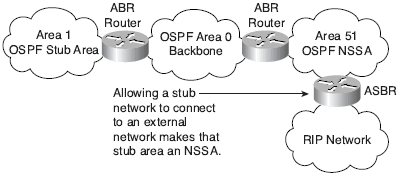Not-So-Stubby Areas
Not-so-stubby areas (NSSAs) are defined in RFC 1587, "The OSPF NSSA Option." NSSAs can be useful for ISPs and large institutions that need to connect to a remote site that runs a different routing protocol. NSSAs allow OSPF to import external routes into a stub area. This is a direct design violation of a regular stub area, and that is why a new RFC was introduced. By defining this new type of area, a new LSA type (Type 7) was also introduced. Using the new LSA, OSPF can now handle this apparent contradiction of importing external routes into a stub area.
NSSAs are useful for instances where you have no Internet transit link and you have to redistribute a legacy RIP network into a stub area, but you still have only a single exit point to other OSPF areas. There are many applications for this because many devices do not speak OSPF (or do not speak it well); these devices can speak RIP.
Figure below illustrates a typical NSSA network topology.

In this tutorial:
- OSPF Basics
- What Is a Routing Protocol?
- Basic Routing Protocol Operation
- Link-State Versus Distance Vector Routing Protocols
- Link-State Routing Protocols
- OSPF Characteristics
- Integrated Intermediate System-to-Intermediate System
- Distance Vector Routing Protocols
- Selecting a Routing Protocol
- Operational Considerations
- Protocols Supported
- Routing Hierarchies
- IP Address Management
- IP Encapsulation Support
- Technical Considerations
- Routing Updates
- Scalability
- Business Considerations
- SPF Overview
- OSPF Routing Hierarchy
- Hierarchical Network Design Techniques
- Routing Types Within an OSPF Network
- External Routes
- OSPF Areas
- Characteristics of a Standard OSPF Area
- Stub Areas
- Not-So-Stubby Areas
- OSPF Operational Environment
- Types of OSPF Routers
- OSPF Network Types
- Router Identification
- Neighbors
- Adjacencies
